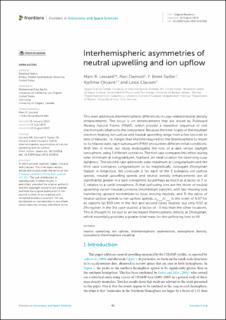| dc.contributor.author | Lessard, Marc R. | |
| dc.contributor.author | Damsell, Alec | |
| dc.contributor.author | Sadler, F. Brent | |
| dc.contributor.author | Oksavik, Kjellmar | |
| dc.contributor.author | Clausen, Lasse | |
| dc.date.accessioned | 2024-03-26T10:19:00Z | |
| dc.date.available | 2024-03-26T10:19:00Z | |
| dc.date.created | 2023-09-08T10:09:21Z | |
| dc.date.issued | 2023 | |
| dc.identifier.issn | 2296-987X | |
| dc.identifier.uri | https://hdl.handle.net/11250/3124192 | |
| dc.description.abstract | This work addresses interhemispheric differences in cusp-related neutral density enhancements. The focus is on enhancements that are driven by Poleward Moving Auroral Forms (PMAF), which provide a repetitive sequence of soft electron precipitation to the ionosphere. Because the time-scales of the resultant electron heating, ion upflow and neutral upwelling range from a few seconds to tens of minutes, i.e., longer than the time required for the thermosphere to return to its relaxed state, each subsequent PMAF encounters different initial conditions. With this in mind, our study investigates the role of a dark versus daylight ionosphere, using 3 different scenarios. The first case compares this effect during solar minimum at Longyearbyen, Svalbard, an ideal location for observing cusp dynamics. The second case addresses solar maximum at Longyearbyen and the third case compares Longyearbyen to its magnetically conjugate Zhongshan Station in Antarctica. We conclude 1) for each of the 3 scenarios ion upflow speeds, neutral upwelling speeds and neutral density enhancements are all significantly greater in a dark ionosphere, by perhaps as much as a factor or 2 or 3, relative to a sunlit ionosphere, 2) that upflowing ions are the driver of neutral upwelling via ion-neutral collisions (momentum transfer), with fast-moving ions transferring upward momentum to slow-moving neutrals, and 3) the ratios of neutral upflow speeds to ion upflow speeds, vnSunlit/viSunlit is the order of 0.07 for all stations (at 800 km) in the first and second cases studied, but only 0.02 at Zhongshan in the 3rd case studied, a factor of ∼3 less than the other locations. This is thought to be due to an increased thermospheric density at Zhongshan, which essentially provides a greater total mass for the upflowing ions to lift. | en_US |
| dc.language.iso | eng | en_US |
| dc.publisher | Frontiers | en_US |
| dc.relation.uri | https://doi.org/10.3389/fspas.2023.1151016 | |
| dc.rights | Navngivelse 4.0 Internasjonal | * |
| dc.rights.uri | http://creativecommons.org/licenses/by/4.0/deed.no | * |
| dc.title | Interhemispheric asymmetries of neutral upwelling and ion upflow | en_US |
| dc.type | Journal article | en_US |
| dc.type | Peer reviewed | en_US |
| dc.description.version | publishedVersion | en_US |
| dc.rights.holder | Copyright 2023 The Author(s) | en_US |
| dc.source.articlenumber | 1151016 | en_US |
| cristin.ispublished | true | |
| cristin.fulltext | original | |
| cristin.qualitycode | 1 | |
| dc.identifier.doi | 10.3389/fspas.2023.1151016 | |
| dc.identifier.cristin | 2173419 | |
| dc.source.journal | Frontiers in Astronomy and Space Sciences | en_US |
| dc.relation.project | Norges forskningsråd: 223252 | en_US |
| dc.identifier.citation | Frontiers in Astronomy and Space Sciences. 2023, 10, 1151016. | en_US |
| dc.source.volume | 10 | en_US |

